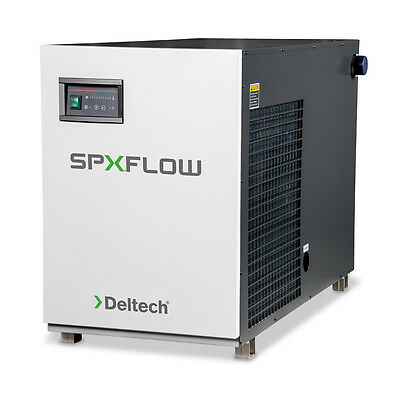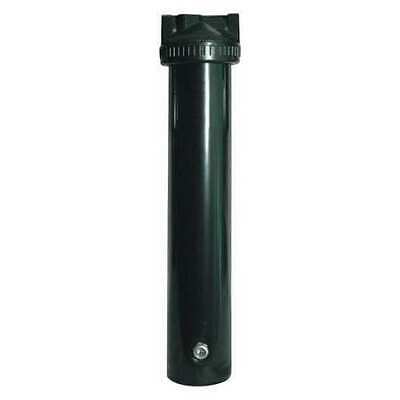-40%
100 CFM Air Dryer for 20 & 25 HP Air Compressors, 1" NPT | HGEN100
$ 1139.42
- Description
- Size Guide
Description
Sales Support -866.778.6572
Capacity (CFM) @ 100/125 PSI
100 CFM
Cooling Type
Air Cooled
Dew Point
+ 39 F
Horsepower (HP)
20 - 25 HP
Max Pressure (PSI)
43.5 - 232 psig (3 - 16 barg)
Min Ambient Temperature
40°F - 109°F (7°C - 43°C)
Operating Pressure (PSI)
100 PSI
TIME PROVEN DESIGN
• 316 stainless steel, brazed plate heat exchangers efficiently dry the air to the specified pressure dew point.
• Hot gas by-pass valve maintains constant evaporator temperature
• Replaceable ambient air filter protects the condenser from airborne contaminants
»» Maintenance kits include ambient air filter
CONDENSATE MANAGEMENT
• Integral stainless demister/separator captures liquid condensate and solid particles
• Electronic drain valve automatically discharges condensate from the dryer
STAY IN CONTROL
• Model 75-150 scfm: Lighted On/Off switch and dew point indicator
• Models 200-500 scfm: Lighted On/Off switch, LED dew point temperature indicator, timer drain adjustment on the panel
SAFETY FIRST — ENVIRONMENTAL FRIENDLY
• CFC free R134a refrigerant
• CSA approved
INSTALLATION
Ambient Air Temperature
Locate the dryer indoors where the ambient air temperature will be between 40°F and 110°F. Intermittent operation at ambient temperatures up to 113°F will not damage the dryer but may result in a higher dew point or dryer shutdown due to high refrigerant discharge pressure (see Field Service Guide).
Do not operate air-cooled dryers at ambient air temperatures below 40°F. Such operation may result in low suction pressure, causing freeze-up.
Location and Clearance
Mount the dryer on a level base. If the base vibrates, bolt the unit down using vibration dampeners. Allow at least 24 inches clearance on the sides and the front of the dryer for cooling airflow and for service access.
System Arrangement
Liquid water in the inlet air will adversely affect the performance of the dryer. Install the dryer downstream of an aftercooler or separator so that the temperature of the dryer inlet air does not exceed 120°F and the inlet air does not contain any liquid water.
If the compressed airflow is relatively constant and does not exceed the dryer flow rating, it is recommended that the dryer be located downstream of the receiver tank. If the nature of the application is such that the air demand regularly exceeds the dryer flow rating, it is recommended that the dryer be located upstream of the receiver.
For safety and convenience, install inlet and outlet shutoff valves and depressurization valves. These valves allow the dryer to be isolated and depressurized for servicing. Bypass piping may be installed around the dryer for uninterrupted airflow when the dryer is serviced. If the compressed air operation cannot tolerate undried air for short periods, install a second dryer in the bypass line.
Compressed air systems commonly require filters to remove compressor oils, particulates, condensed liquids and other contaminants. When an oil-removal filter is used, it should be installed downstream of the refrigerated dryer. At this location, the life of the replaceable filter element is prolonged since some of the entrained oil is removed by the dryer and drained through the separator.
Piping and Connections
Piping must be furnished by the user unless otherwise specified. Connections and fittings must be rated for the maximum operating pressure given on the dryer data plate and must be in accordance with applicable codes. Support all piping; do not allow the weight of any piping to stress the dryer or filter connections. Inlet and outlet shutoff valves and a valved bypass valve are recommended. Piping should be at least the size of the inlet and outlet connections to minimize pressure drop in the air system. See Engineering Data section for dryer inlet and outlet connections.
Removing Condensate
Condensate must be drained from the dryer to prevent re-entrainment. The dryers are equipped with automatic drain valves and internal drain hoses up to the drain connections on the dryer cabinets. The user must install a separate discharge line at the drain connection to carry off condensate to an environmentally approved condensate collection/disposal system. Piping or copper tubing 1/2 inch or larger is recommended for condensate discharge lines. Install the drain lines so that condensate can be seen as it drains.
Electrical Connections
The dryers are constructed according to NEMA Type 1 electrical standards. Field wiring must comply with local and national fire, safety and electrical codes. Installation must be in accordance with the National Electrical Code. Confirm that your line voltage is the same as the voltage listed on the dryer data plate. Refer to Figure 1 for electrical schematics.
ON/OFF Switch
The dryer is equipped with an ON/OFF switch on the front panel. A light signals when the dryer is on.
Warranty Period
Parts and labor for two (2) years from the date of shipment from the factory; heat exchangers are covered (parts only) for an additional three (3) years (total of five [5]). On units that manufacturer requests be returned to the factory, a one time removal/reinstallation labor allowance as noted in the Service Warranty Policies and Procedures Handbook will apply. Freight to the factory from the installation site and to the installation site from the factory will be paid by the manufacturer; means of transportation to be specified by manufacturer.











